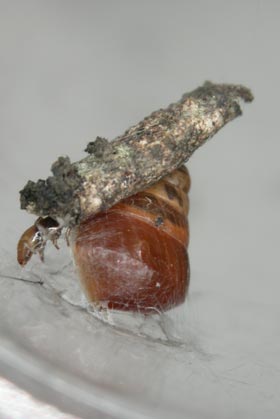Flesh-Eating Caterpillars Discovered in Hawaii
Most Hawaiian organisms exploit niches like those that similar organisms use on the mainland, Gillespie said. "But you also get oddballs showing up that evolve to do something you don't expect them to do at all."
In addition to the newly discovered flesh-eating caterpillars, the Hawaiian Islands are home to caterpillars and spiders that snatch flies out of midair and devour them.
Rubinoff was skeptical when colleagues first reported the possibility of snail-eating caterpillars on Maui. Of the approximately 150,000 described species of moths and butterflies, only about 200 species are predators, and all of those eat other insects.
He thought his colleagues had discovered a quirky individual but decided to take a look.
Rubinoff collected some caterpillars from the site and tried to feed them lichens, carrots, and other common Hyposmocoma caterpillar foods. They ate nothing. Then he fed them a snail, and a caterpillar quickly went to work, binding it to the glass of the laboratory jar.
Since then, Rubinoff and his lab have confirmed the existence of flesh-eating caterpillars on the islands of Molokai, Kauai, and the Big Island (Hawai'i). The caterpillars are all found in rain forest habitat and dine exclusively on snails.
"Not only is it not a fluke, but it is a radiation of snail-eating caterpillars," he said.
Habitat Conservation
The question Rubinoff now ponders is why this feeding strategy evolved in Hawaii and apparently nowhere else in the world.
"Maybe because of Hawaii's isolation, it spawns evolutionary experiments that don't seem to occur anywhere else on the planet," he said.
And perhaps the "incredibly ecologically diverse genus" of Hyposmocoma is the pre-requisite that allowed for the evolutionary experimentation, he added.
The flesh-eating caterpillars are found in Hawaii's rain forests, which are becoming increasingly rare. The discovery of the insects serves as "another reason to save what's left of the native Hawaii biota," Rubinoff said.
Saving and studying these unique insects and their habitat may eventually shed additional light on how evolution operates, he noted.
Gillespie, the Berkeley researcher, said researchers first need to collect more information on where these flesh-eaters fit in the huge and varied genus of Hyposmocoma.
"Then we can get insight into how evolution works," she said.
Free E-Mail News Updates
Sign
up for our Inside National Geographic newsletter. Every two
weeks we'll send you our top stories and pictures (see
sample).
MOST POPULAR STORIES
Photo in the News: Oldest Known Maya Mural Reveals Royal TaleArchaeologists have revealed the final wall of the earliest known Maya mural, sa... |
Oldest Known Maya Mural, Tomb Reveal Story of Ancient KingArchaeologists have revealed the final wall of the earliest known Maya mural, sa... |
King Kong Island Home Is Pure Fantasy, Ecology Experts SaySkull Island, the mythical home of the great ape King Kong, is supposed to lie i... |
|
||||||||||









